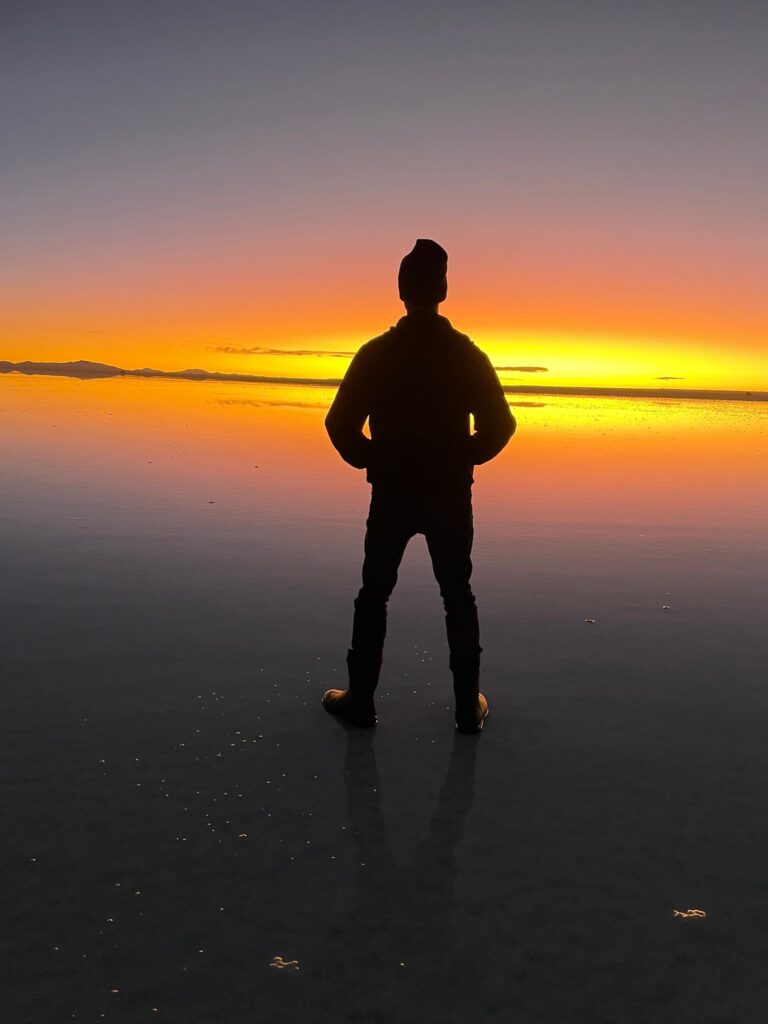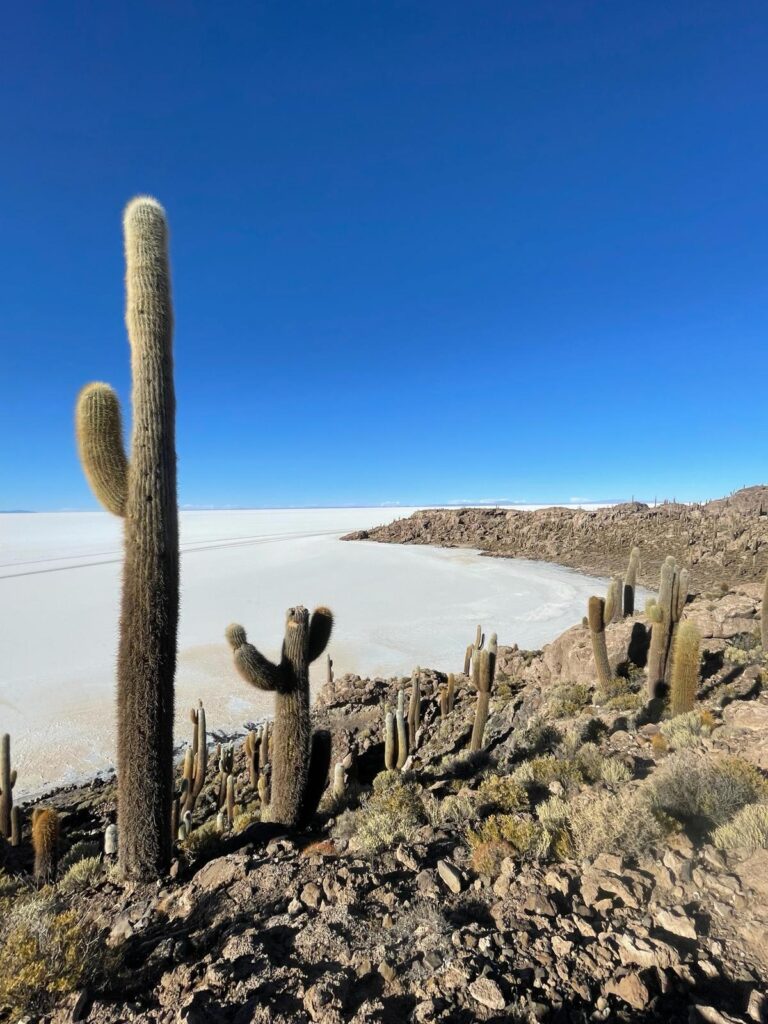When Is The Best Time To Visit Salar De Uyuni?
The best time to visit Salar de Uyuni is during the rainy season from December-March to see the famous mirror effect where everything reflects off the salt looking just like a mirror. The best climate is in October and November which are two of the warmest months, but without the rainfall that follows from December onwards.
Below I will go into more detail about what weather you can expect throughout the year at one of the most stunning sites in South America.

What Are The Seasons In Uyuni?
There are only two seasons in Bolivia, which also extend to Uyuni.
The wet season runs from December-March. This is the Bolivian summer and has the warmest temperatures, but by far the wettest weather.
The dry season runs from April-November. These are the cooler months with less rainfall. I went at the end of August and it was freezing, so be sure to wrap up warm during this period.
April and November may also be referred to as the shoulder season, as both have much higher temperatures than the winter months, but a lot less rainfall than the summer months.
Temperatures In Uyuni
There’s little variation in temperatures throughout the year, but let’s have a look at exactly how hot it gets.
| Monthly Temp. | Jan | Feb | Mar | Apr | May | Jun | Jul | Aug | Sep | Oct | Nov | Dec |
|---|---|---|---|---|---|---|---|---|---|---|---|---|
| Average | 11 °C 51 °F | 10 °C 51 °F | 10 °C 50 °F | 8 °C 47 °F | 5 °C 41 °F | 3 °C 38 °F | 3 °C 37 °F | 4 °C 40 °F | 7 °C 44 °F | 9 °C 49 °F | 11 °C 52 °F | 12 °C 53 °F |
| Minimum | 5 °C 41 °F | 5 °C 41 °F | 4 °C 39 °F | 1 °C 33 °F | -3 °C 27 °F | -3 °C 26 °F | -4 °C 25 °F | -3 °C 26 °F | -2 °C 28 °F | 0 °C 32 °F | 2 °C 35 °F | 5 °C 40 °F |
| Maximum | 17 °C 62 °F | 16 °C 61 °F | 17 °C 62 °F | 16 °C 61 °F | 13 °C 55 °F | 11 °C 52 °F | 11 °C 51 °F | 13 °C 55 °F | 15 °C 59 °F | 17 °C 63 °F | 19 °C 66 °F | 19 °C 66 °F |
As you can see, temperatures remain pretty consistent across the whole year. You’re looking at a visit during the wet season if you wish to experience the warmest weather.
Rainfall And Precipitation In Uyuni
The wet season lasts from December 12th-March 14th with up to a 40% chance of rain. A 2-3 week period from late December to mid-January brings the wettest weather.
There is a small chance of snowfall between April and October, albeit with no more than 1.2 inches expected, generally in August.
August in Uyuni is very cold, so this shouldn’t be a surprise to anyone who has been in this month.
What Is The Mirror Effect?
The mirror effect occurs when the salt flats become flooded with water and the resulting landscape looks like, well, a mirror.
Everything looks symmetrical with the skies and other background objects becoming visible on the ground making the perfect backdrop for a photo.
You should wear boots to wade through the water and avoiding getting your feet soaked. Then you can walk along the flats without issues and take the best possible photos! And believe me when I say you will want to take many photos here.
To get the best photos, stand still in the water to avoid ripples and you will get some truly awesome pictures.
Only a handful of other destinations worldwide, such as Salar de Atacama in neighbouring Chile and Canada’s “Mirror Lake” at Banff National Park give off a similar effect.

Other Things To Know Before Visiting Salar De Uyuni
You can visit without a guided tour, but to be honest the tours are very good value (I paid £28.02/US$35.40 although the price has gone up slightly since then), and the guides will take you to the best places including cactus-filled Isla Incahuasi and the Dakar Rally monument, which pays tribute to the famous race that once crossed through Bolivia. You will also visit an abandoned train graveyard (sounds cool, but you’ll be there with dozens of other tourists and it’s massively overshadowed by the salt flats) and a small market full of items made from salt. Therefore my first tip would be to take a guided tour to make the most of this spectacular location.
Speaking of which, book tours in Uyuni town. They are much cheaper than booking online. Online tours are generally marketed towards western tourists and often involve a middle man who takes a cut of the money, so you’re better off going door-to-door in Uyuni for the best price. Although the tour I mentioned above was booked online, so it doesn’t cost too much either way.
Also remember that the weather is very cold here. So wrap up warm.
On top of that, make sure you wear gloves. Now the salt may be beautiful to look at, but it’s incredibly painful if you fall over, scrape your hands open and (quite literally) end up rubbing salt into the wound. If this sounds oddly specific, then yes, I am speaking from experience. Falling over here led to my hands bleeding for around 18 hours even through the plasters I put on top. I ended up being tortured in a tiny hospital in Chile’s Atacama Desert, suffered greatly for a couple of weeks, and didn’t really start recovering until a lovely local on beautiful Easter Island patched things up for me. Just wear gloves and avoid this!
Now if you’re looking for low crowds, travel during the wet season. This way you will have more accommodation options, and more opportunities to experience the mirror effect with a smaller group.

My Personal Experiences Visiting Salar De Uyuni
I’m lucky enough to have been to some of the world’s most incredible places. Archeological wonders such as Easter Islands and the Pyramids of Giza, the spooky city of Pripyat which was abandoned after the Chernobyl nuclear disaster, and so much more. But Salar de Uyuni may just be the best of all.
I booked a tour which included the salt markets, abandoned train graveyard, Dakar monument and Isla Incahuasi. But the highlight by far was the sunset.
Despite being freezing cold, even with warm clothing, there was something truly magical about standing in the puddles on the salt as the clear skies turned from light blue to dark orange to purple to orange again and finally black in the space of just half an hour.
Even with other tour groups around, witnessing this phenomenon is incredibly serene. It was one of those “this is why I travel” moments. Serious bucket list stuff and I’d recommend visiting to anyone. Bolivia is just about the cheapest country in Latin America so your budget will go a long way here, even for Americans who must pay a US$160 visa fee.
Share your experiences visiting Uyuni, or your expectations if you’re yet to visit in the comments below!
